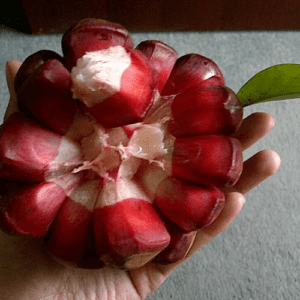When talking about the Kadsura Dragon™ Vine fruit in 1999, Katy Warren, who is known as the ‘Queen of Kiwano Melon’ for her national introduction of the brilliantly yellow-and-neon-green horned cucumber; now sold to nearly every major food chain in the USA, remarked, “It’s just crazy that this ‘giant raspberry-like fruit, isn’t found in stores across the US; that’s our goal”.
 “This vine is remarkable because it remained hidden away and was uncultivated for so long” reported Jerome Black, who made several expeditions in the 1990s to find it.
“This vine is remarkable because it remained hidden away and was uncultivated for so long” reported Jerome Black, who made several expeditions in the 1990s to find it.
“The four species that Katy and I planted have flavors that range from mild-grape and lychee-flavor to light peach or cherry, although all very subtle and floral in flavors. The fruit is beautiful to look at and has a lot of curb appeal.”
Black speculated that the remoteness of China’s hill tribe regions, with the fact that China had been off-limits to most foreign travelers, especially between 1966, and until re-opening to solo tourist travel around 1989, are what kept this giant berry a botanical mystery. “It had simply been a fruit traded in indigenous markets in remote mountain areas that were very hard to access, and some regions still are”, He added. “It was a relative secret traded between hill tribes who made the original discovery hundreds of years ago.”
The Kadsura Dragon™ Vine fruit has a high edibility rating that is often used raw as fresh fruit, or even cooked. Aside from the tasty fruit, they are astounding in size and look like a giant raspberry or blackberry, with fruits as large as 3 to even 6 inches in diameter. Fruits weigh from half a pound to even 2 pounds each, which are typical from each harvest. These vines are heavy producers and known to produce up to 2 to 3 tons per acre.